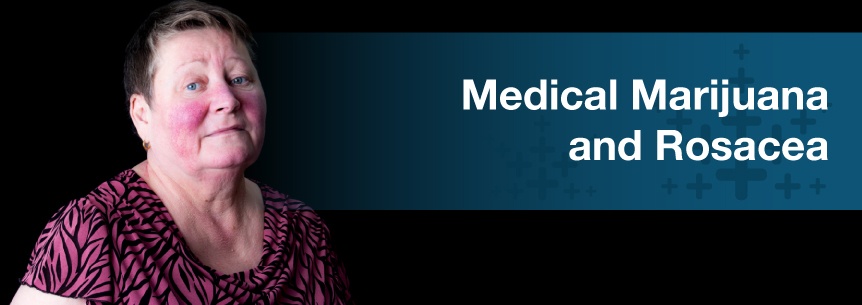
Some individuals believe a sign of good health is a rosy complexion. However, facial redness, particularly in patches, can also be pointing to something more distressing — the long-lasting skin condition known as rosacea. Luckily, along with other treatments to help manage this skin disorder, medical cannabis can help with many of rosacea’s symptoms including pain, inflammation, anxiety, depression and more.
Whether its oral or topical, medical marijuana can have a therapeutic effect on patients with rosacea. Medical marijuana and rosacea treatment not only helps treat your skin condition but may also have properties to make your skin look younger. Chemicals in cannabis known as cannabinoids are powerful anti-inflammatory agents and antioxidants.
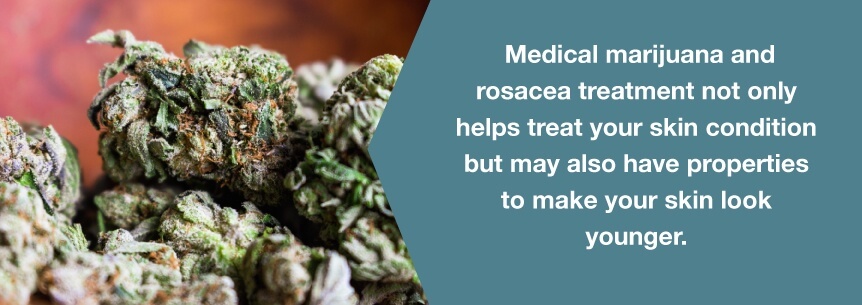
A study in 2013 found THC decreases allergy-related inflammation. Medical weed is essential for future strategy development by harnessing cannabinoids for treating inflammatory skin disorders. While there’s limited research on marijuana for rosacea, there is anecdotal evidence cannabis helps those suffering from rosacea.
Along with helping patients’ physical rosacea symptoms like inflammation and pain, many patients report cannabis and rosacea treatment also helps with symptoms like:
Medical pot also has anti-inflammatory properties and antioxidants, as mentioned, to decrease significantly the inflammation and redness patients experience on their faces.
Certain strains work better than others at tackling skin problems. Some strains that have already been found to treat eczema effectively, may also help with rosacea. These marijuana and rosacea strains include:
Applying cannabis for rosacea topically and using other cannabis-infused skin products will probably benefit you more as a rosacea treatment than other methods. One popular form used for rosacea symptoms is hemp seed oil. It provides an excellent source of important fatty acids as well as an array of nutritional benefits. Hemp seed oil contains metabolites like stearidonic acid, gamma-linoleic acid (GLA) and oleic acid. These all help to treat inflammation-related skin conditions like eczema and rosacea.
A study in 2005 showed hemp seed oil helped improve eczema, particularly in decreasing dryness and itchiness due to its polyunsaturated fatty acid content. The fatty acids also help treat redness and irritation rosacea causes. Hemp seed oil also improves skin elasticity while it reduces the redness rosacea causes. Marijuana’s cannabinoids help balance cell growth and relieve inflammation.
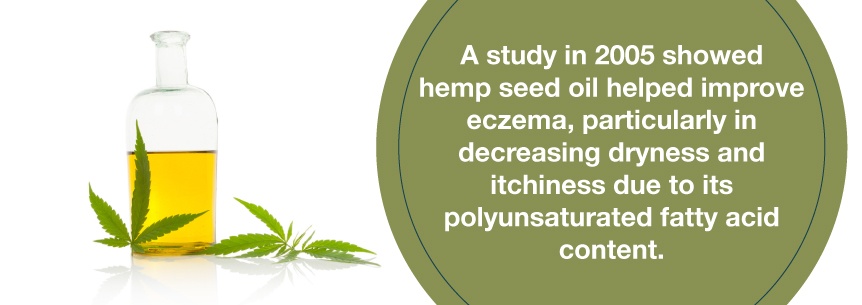
Cannabis oil is another good topical alternative and is rich in certain vitamins, especially numerous B vitamins and C, D and E. It also contains high omega-3 and -6 content. These both protect skin against aging and promote circulation. Since it promotes circulation, cannabis oil applied to the skin can also help reduce rosacea symptoms.
Other methods of cannabis delivery are:
You now have information on cannabis and rosacea treatment to help you make an informed decision if it’s a good choice for treating your symptoms. You have a huge selection of cannabis products to help treat your skin disorder and bring your skin back to its healthy state.
Search for a medical marijuana doctor and dispensary easily here at MarijuanaDoctors.com. We’ll connect you with a qualified doctor who can give you your recommendation for medical cannabis so you can begin treating your rosacea symptoms and finally find relief.
Find A Doctor Find A Dispensary
Rosacea is a common skin disorder causing visible blood vessels and redness in your face. It might also produce small, pus-filled, red bumps. The symptoms might flare up for a few weeks or months and then go back into remission for a while. Many people mistake rosacea for an allergic reaction, acne or another skin problem.
The skin disorder often starts out as redness on your chin, forehead, cheeks or nose. It often looks like an outbreak of acne. However, the disorder can get worse over time. Inflammation can cause your skin to become sensitive and swollen. Thick, red, bumpy skin might appear on your face and cause you distress and discomfort.
Some individuals with the skin condition also develop eye problems. When this happens, your eyelids could become inflamed, impairing your vision.
Anyone can develop rosacea, but it often affects fair-skinned, middle-aged women. Around 16 million people in the U.S. have rosacea according to the National Rosacea Society.
While rosacea doesn’t have a cure, treatments can reduce and control symptoms.
Facial redness is the typical symptom of rosacea. Rosacea typically leads to a persistent redness in the central features of your face. Small blood vessels on your cheeks and nose will likely become visible and swell.
Other symptoms of rosacea to look out for include:
If you’re experiencing persistent facial redness, see your doctor or dermatologist for treatment.
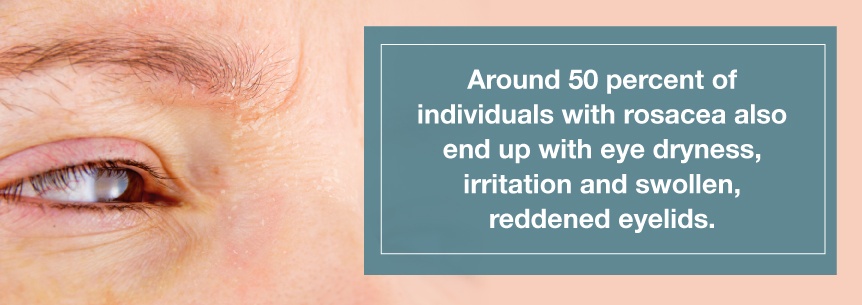
Researchers are still attempting to find the cause of rosacea. They have found some potential causes, which include:
There are four subtypes of rosacea, according to the Academy of Dermatology. These are:
Rosacea is not uncommon. If you have rosacea, you’re not alone. Even some famous people, like President Bill Clinton and Diana, Princess of Wales, had the skin condition.
The condition can lead to:
Let’s explore this “emotional distress” a little more.
Rosacea affects how you look which can lower your self-confidence and make you self-conscious. When you have a flare, you may try to avoid social situations out of embarrassment. This can result in depression and isolation. The skin disorder may also cause social stigmatization and substantially reduce your quality of life.
Rosacea’s psychosocial impact is often debilitating and severe. Individuals with rosacea have a higher risk of developing anxiety and depression, according to research published in the journal Clinical, Cosmetic and Investigational Dermatology. One study showed the presence of symptoms of depression might not have so much to do with the disorder’s severity, but instead, the patients’ subjective rosacea perception.
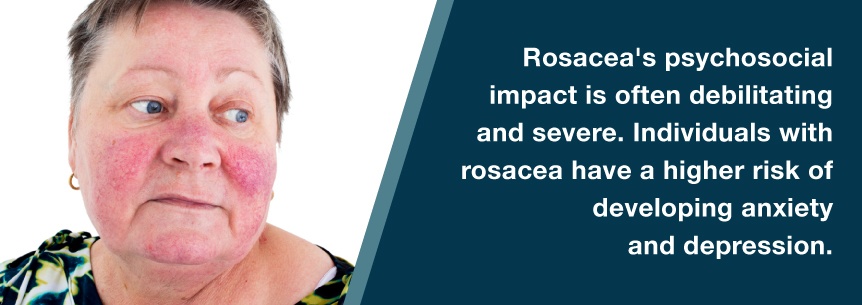
A French surgeon, Dr. Guy de Chauliac, was the first individual to medically describe rosacea in the 14th century. He described red facial lesions, especially on the cheeks and nose. He referred to the disorder as couperose, which is the French term used today for rosacea, or “goutterose,” which is French for the term “pink droplet.”
Other people called rosacea “pustule de vin” which meant “pimples in wine” in French or “gutta rosa,” the Latin version of goutterose.
There aren’t any specific tests to diagnose rosacea. Doctors instead rely on your symptoms and a physical exam of your skin. Sometimes, your physician might conduct testing to rule out other disorders like:
These disorders in some cases cause symptoms similar to rosacea’s symptoms.
Your doctor might recommend you see an ophthalmologist — an eye specialist — if rosacea affects your eyes.
Treatment focuses on controlling your symptoms. Often treatment involves prescription medications and skin care. The severity and type of symptoms you have determine the type of medicine your doctor will prescribe. Prescription rosacea medications include:
The drug brimonidine (Mirvaso) can help reduce redness effectively. You apply it to your skin in gel form. It constricts your blood vessels. The effects are only temporary, so you’ll need to reapply it regularly to continue experiencing improvements. Side effects of brimonidine include:
Metronidazole and azelaic acid are other topical products shown effective for reducing mild rosacea’s pimples and redness. Side effects of these medications may include:
Antibiotics help by reducing some forms of bacteria, but when used specifically for this disorder, may fight inflammation. One type of antibiotics your doctor may prescribe is doxycycline and helps with pustules and bumps in severe rosacea. Other types of oral antibiotics prescribed for rosacea include minocycline and tetracycline. Side effects of antibiotics include:
If you’re struggling with severe rosacea and it’s not responding to other treatments, your doctor may recommend isotretinoin. It’s a strong oral medication for acne also designed to get rid of rosacea’s acne-like lesions. It can cause severe birth defects. Therefore, you don’t want to use it if you’re pregnant. Other side effects may include:
Since rosacea is chronic, you’ll have to learn how to manage it. Coping with a chronic disorder can be difficult. Finding online message boards or support groups will help since you can connect with others dealing with the same thing.
Researchers are beginning to connect the dots in the inflammation process of rosacea and are finding a possible pathway for substantial treatment advances. They’ve already identified mast cells that contribute to the activation of particular forms of cathelicidins, which make up part of the immune system. Mast cells reside in connective tissue. They release histamine during allergic and inflammatory reactions.
Some researchers are looking further into areas they’ve already seen success with in previous studies while others are branching out into new frontiers they’ve never studied before. Both of these can help with gaining a better understanding of the skin condition and yielding essential treatment advances and maybe even a cure.
Also, researchers are studying rosacea in about 140 clinical trials, and other clinical trials have been and are being conducted for ocular rosacea.